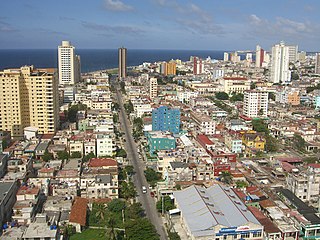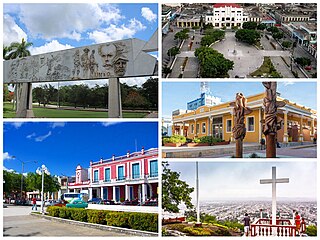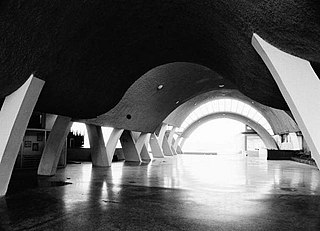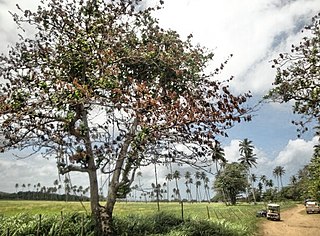Transportation in Cuba is the system of railways, roads, airports, waterways, ports and harbours in Cuba:

Havana is the capital and largest city of Cuba. The heart of the La Habana Province, Havana is the country's main port and commercial center. It is the most populous city, the largest by area, and the second largest metropolitan area in the Caribbean region. The population in 2002 was 2,137,847 inhabitants, and its area is 728.26 km2 (281.18 sq mi) for the capital city side and 8,475.57 km2 for the metropolitan zone.

La Habana Province, formerly known as Ciudad de La Habana Province, is a province of Cuba that includes the territory of the city of Havana, the Republic's capital. The province's territory is the seat of the superior organs of the state and its provincial administration.

Holguín is a municipality-city in Cuba. After Havana, Santiago de Cuba, and Camagüey, it is the fourth largest city in Cuba.

The Almendares River is a river that runs for 47 km in the western part of Cuba. It originates from the east of Tapaste and flows north-west into the Straits of Florida. The river acts as a water supply for Havana.

Aerogaviota is an airline based in Havana, Cuba. It operates domestic flights within Cuba as well as flights from Cuba to Jamaica. Its main base is Playa Baracoa, Havana, although it occasionally flies out of and into José Martí International Airport, Havana.

Vedado is a central business district and urban neighborhood in the city of Havana, Cuba. Bordered on the east by Calzada de Infanta and Central Havana, and on the west by the Alemendares River and Miramar / Playa district, Vedado is a more modern part of the city than the areas to the east, developed in the first half of the 20th century, during the Republic period. In 2016 it was described by one commentator as the city's "most affluent" section. The main street running east to west is Calle 23, also known as "La Rampa". The northern edge of the district is the waterfront seawall known as the Malecón, a famous and popular place for social gatherings in the city. The area popularly referred to as 'Vedado' consists of the wards of Vedado, Rampa, Vedado-Malecón and Carmelo, all in the municipality of Plaza de la Revolución.

Miramar is a residential district of the municipality of Playa, in the city of Havana.

José Ramón Villa Soberón is a Cuban artist, particularly known for his public sculptures around Havana. He studied at the Escuela Nacional de Arte in Havana, Cuba and the Academy of Plastic Arts in Prague. He is a professor at the Instituto Superior de Arte in Havana. His sculptures, paintings, engravings, drawings and designs are held by the Museo Nacional de Bellas Artes de La Habana, and in 1996 he was one of the selected artist in the second Trienal Americana de Escultura in Argentina.

Club Náutico is a building in Cuba. It is in the reparto of Náutico, Playa, Havana.

Leonardo Morales y Pedroso was one of the most prominent Cuban architect in Cuba in the first half 20th century. In 1900 he entered and attended pre-university studies at De Witt Clinton High of New York, where he obtained a bachelor's degree. In 1909 he graduated of Bachelor in Architecture from Columbia University. After graduating, he returned to Cuba in 1909 where he worked a time in the local architect firm of Newton & Sola with the architect Thomas M. Newton, who was director of the civil construction section of the Secretary of Public Works during the 2nd American intervention in Cuba. In February 1910, he returned to the United States and obtained a master's degree (Doctor) in Architecture from Columbia University in the State of New York. After obtaining his doctorate in architecture he joined in March 1910 the architecture Company Morales y Mata arquitectos, created in 1907 by his elder brother the engineer Luis Morales y Pedroso in association with the master builder Jose F. Mata. In 1917, after having built more than 30 important buildings, they decided to separate from José Mata, who had to stop working because illness and died a short time later. The company changed its name for Morales y Compañia Arquitectos with his brother the engineer Luis Morales y Pedroso as president and Leonardo as Associate together with other 7 architects. He was able to obtain noteworthy real estate commissions partly because of his family's origin, good social connections and social standing in Havana high society. He was named by the Cuban press of the time as the "Havana's architect" and his architectural style is recognized as the "Morales style". During 50 years Leonardo Morales y Pedroso received around 250 notable architectural commissions, some of them include:
Nelson Ponce Sanchez was born in 1975, in Alamar. He is an illustrator and graphic designer, especially known for his Vampiros en La Habana poster, as well as his active participation in the Camaleón collective.

Borinquen is a barrio in the municipality of Aguadilla, Puerto Rico. Its population in 2010 was 7,415.
The following is a timeline of the history of Havana, Cuba.

Calabazar is a ward of the city of Havana, the capital of Cuba, belonging to the municipal borough of Boyeros. In 2011, it had a population of 20,069.

Hospital de San Lázaro was a hospital in the city of Havana, Cuba. It dates back to the 17th century, when it served as headquarters for some huts built near the Caleta de Juan Guillén, then known as Caleta de San Lázaro, in an area about a mile outside the city walls.

The Parque de la Fraternidad was built in the 1790s as a military practice range by the Spanish government, It was expanded in 1793 by Belgian engineer Agustin Cramer, and later Bishop Espada improved the lighting of the Campo. It was Captain General Don Miguel Tacón who included it within the scope of his embellishment program. The area was then fenced and four majestic gates, crowned with coats of arms, each representing an important personality: the north gate, Hernán Cortés; the south one, Francisco Pizarro; and the east and west gates, Captain General Miguel Tacón y Rosique (1834–1838), and Christopher Columbus respectively.

















